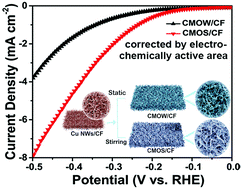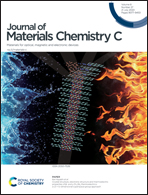Dynamically controlled growth of Cu–Mo–O nanosheets for efficient electrocatalytic hydrogen evolution†
Abstract
The development of low-dimensional non-precious metal catalysts for the hydrogen evolution reaction (HER) is highly desired for clean energy utilization. Herein, we have reported a facile synthesis protocol of Cu–Mo–O (CMO) nanowires and nanosheets on Cu foam (CMOW/CF and CMOS/CF) through a one-step reaction of Cu nanowires with (NH4)6Mo7O24 solution directly under mild conditions. The final product morphology has been tuned by mechanical stirring. The as-synthesized CMOS/CF exhibits a low operating overpotential of 112 mV at a current density of 10 mA cm−2 with a high electrochemical active area of 25.1 mF cm−2 and excellent long-term stability in the 1 M KOH electrolyte. Moreover, by using the CMOS/CF as cathodic and anodic electocatalysts, a two-electrode electrolyzer capable of driving 10 mA cm−2 at a cell voltage of 1.69 V was achieved, along with promising stability. The high performance of the CMOS/CF can be attributed to higher electrochemical area and more Mo catalytic sites induced by mechanical stirring. This work provides a facile method for the synthesis and catalytic site regulation through a simple method of low-dimensional nanomaterials for the HER with relatively high electrochemical active area and catalytic activity.



 Please wait while we load your content...
Please wait while we load your content...